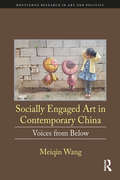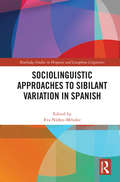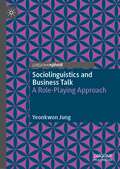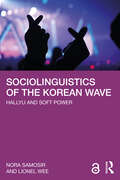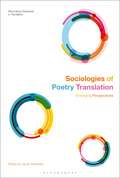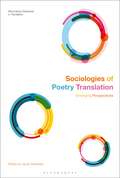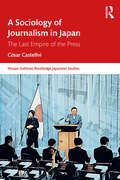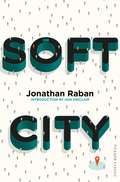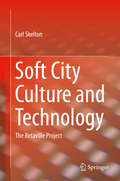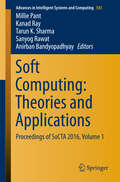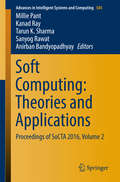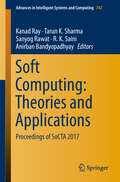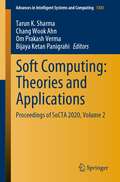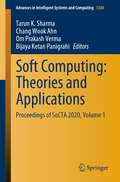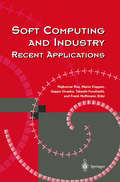- Table View
- List View
The “Socialist Transformation” of Memory: Reversing Chinese History through “Pernicious-Vestiges” Media Discourse (China Perspectives)
by Yusi Liu Ye MaThrough discourse analysis and historical comparison of "Pernicious Vestiges" (Yí Dú/遗毒) narrative in the news text of People’s Daily, this book is devoted to revealing its primary metaphors and political functions in China. "Pernicious Vestiges" (Yí Dú/遗毒) is one of the most frequently used words in contemporary Chinese historical narration, as well as a constantly changing rhetorical direction in new China's media discourse, whose function is to remold memory. Over the past 76 years, the "Pernicious Vestiges" narrative continuously constructed by People’s Daily, the official newspaper of the CPC Central Committee, reflects the views of China’s political elite and represents the ruling party's evaluation and re-evaluation of historical events. The findings of this book challenge the myth that memory is naturally superior to forgetting, reflect on the ethics of memory in "Pernicious Vestiges" narratives and the erasure of their own justice, and suggest that the critical space compressed by "Pernicious Vestiges" narratives should be returned to restore the order of memory and historical reflection. This book will be an excellent read for students and scholars of Chinese studies, media studies, and those who are interested in political communication and collective memory in general.
Socially Engaged Art in Contemporary China: Voices from Below (Routledge Research in Art and Politics)
by Meiqin WangThis book provides an in-depth and thematic analysis of socially engaged art in Mainland China, exploring its critical responses to and creative interventions in China’s top-down, pro-urban, and profit-oriented socioeconomic transformations. It focuses on the socially conscious practices of eight art professionals who assume the role of artist, critic, curator, educator, cultural entrepreneur, and social activist, among others, as they strive to expose the injustice and inequality many Chinese people have suffered, raise public awareness of pressing social and environmental problems, and invent new ways and infrastructures to support various underprivileged social groups.
Socially Engaged Art in Contemporary China: Voices from Below (Routledge Research in Art and Politics)
by Meiqin WangThis book provides an in-depth and thematic analysis of socially engaged art in Mainland China, exploring its critical responses to and creative interventions in China’s top-down, pro-urban, and profit-oriented socioeconomic transformations. It focuses on the socially conscious practices of eight art professionals who assume the role of artist, critic, curator, educator, cultural entrepreneur, and social activist, among others, as they strive to expose the injustice and inequality many Chinese people have suffered, raise public awareness of pressing social and environmental problems, and invent new ways and infrastructures to support various underprivileged social groups.
Society 5.0: Industry of the Future, Technologies, Methods and Tools
by Bruno SalguesFollowing the rapid development of connected technologies, which are now highly sophisticated and spread across the globe, Society 5.0 has emerged and brought with it a dramatic societal shift. In 1998, Kodak, the world leader in photographic film, had 170,000 employees. It thus seemed unthinkable that just 3 years later, the majority of people would stop taking photographs to paper film and that Kodak would have disappeared. These are the stakes of this new society that is taking shape. This book, which does not seek to critique current politics, management or marketing literature, aims to fight against the excesses of this often-misunderstood Society 5.0 and to present the ideas and associated technologies that comprise it, all working towards societal improvement. Among these technologies, artificial intelligence, robotics, digital platforms and 3D printing are undoubtedly the most important, and thus receive the greatest focus.
Society 5.0: Industry of the Future, Technologies, Methods and Tools
by Bruno SalguesFollowing the rapid development of connected technologies, which are now highly sophisticated and spread across the globe, Society 5.0 has emerged and brought with it a dramatic societal shift. In 1998, Kodak, the world leader in photographic film, had 170,000 employees. It thus seemed unthinkable that just 3 years later, the majority of people would stop taking photographs to paper film and that Kodak would have disappeared. These are the stakes of this new society that is taking shape. This book, which does not seek to critique current politics, management or marketing literature, aims to fight against the excesses of this often-misunderstood Society 5.0 and to present the ideas and associated technologies that comprise it, all working towards societal improvement. Among these technologies, artificial intelligence, robotics, digital platforms and 3D printing are undoubtedly the most important, and thus receive the greatest focus.
The Socio-Cognitive Approach to Communication and Pragmatics (Perspectives in Pragmatics, Philosophy & Psychology #33)
by Istvan KecskesThe book aims to serve as a theoretical framework for the socio-cognitive approach (SCA) that is an alternative to the two main lines of pragmatics research: linguistic-philosophical pragmatics and sociocultural-interactional pragmatics. SCA broadens the scope of the field with an intent to incorporate not only L1 communication but also intercultural communication, and communication in a second language. The author integrates the pragmatic view of cooperation and the cognitive view of egocentrism and emphasizes that both cooperation and egocentrism are manifested in all phases of communication, albeit to varying extents. SCA places equal importance on the social and cognitive individual factors in pragmatics. The author claims that while (social) cooperation is an intention-directed practice that is governed by relevance, (individual) egocentrism is an attention-oriented trait dominated by salience.The book serves as a theoretical guide for researchers and students who would like to understand how we need to change first language-based theories to make sense of what happens not only in L1 but also in intercultural and multi-lingual interactions.
Sociolinguistic Approaches to Sibilant Variation in Spanish (Routledge Studies in Hispanic and Lusophone Linguistics)
by Eva Núñez-MéndezSocial processes and the nature of language variation have driven sibilant variation across the Spanish-speaking world. This book explores the current state of Spanish sibilants and their dialectal variations. Focusing on different processes undergone by sibilants in Spanish (e.g., voicing, devoicing, weakening, aspiration, elision) in various geographical areas and language contact situations, each chapter offers an analysis on a unique sociolinguistic case from different formal, experimental, and data-based approaches. The opening chapter orients the reader with an overview of sibilant system’s evolution, which serves as an anchor to the other chapters and facilitates understanding for readers new to the topic. The volume is organized around three thematic sections: part one, Spain; part two, United States; and part three, Central and South America. The collection includes research on dialects in both Peninsular and Trans-Atlantic Spanish such as Jerezano, Caribbean Spanish in Boston and New York City, Cuban Spanish in Miami, Colombia-Barranquilla Spanish, northern Buenos Aires Argentine Spanish, and USA heritage Spanish, among other case studies. This volume offers an original and concise approach to one of the most studied variables in Spanish phonetics, taking into account geographically-based phonetic variation, sociolinguistic factors, and various Spanish language contact situations. Written in English, this detailed synthesis of the wide-ranging geolinguistic features of Spanish sibilants provides a valuable resource for scholars in Hispanic studies, linguistics, Spanish dialectology and sociolinguistics.
Sociolinguistic Approaches to Sibilant Variation in Spanish (Routledge Studies in Hispanic and Lusophone Linguistics)
by Eva Núñez-MéndezSocial processes and the nature of language variation have driven sibilant variation across the Spanish-speaking world. This book explores the current state of Spanish sibilants and their dialectal variations. Focusing on different processes undergone by sibilants in Spanish (e.g., voicing, devoicing, weakening, aspiration, elision) in various geographical areas and language contact situations, each chapter offers an analysis on a unique sociolinguistic case from different formal, experimental, and data-based approaches. The opening chapter orients the reader with an overview of sibilant system’s evolution, which serves as an anchor to the other chapters and facilitates understanding for readers new to the topic. The volume is organized around three thematic sections: part one, Spain; part two, United States; and part three, Central and South America. The collection includes research on dialects in both Peninsular and Trans-Atlantic Spanish such as Jerezano, Caribbean Spanish in Boston and New York City, Cuban Spanish in Miami, Colombia-Barranquilla Spanish, northern Buenos Aires Argentine Spanish, and USA heritage Spanish, among other case studies. This volume offers an original and concise approach to one of the most studied variables in Spanish phonetics, taking into account geographically-based phonetic variation, sociolinguistic factors, and various Spanish language contact situations. Written in English, this detailed synthesis of the wide-ranging geolinguistic features of Spanish sibilants provides a valuable resource for scholars in Hispanic studies, linguistics, Spanish dialectology and sociolinguistics.
Sociolinguistics and Business Talk: A Role-Playing Approach
by Yeonkwon JungThis book delivers essential skills in “spoken” professional communications, presenting theoretical and applied frameworks for business talk using English as a lingua franca. Adopting a role-playing approach mimicking various professional settings, it assesses the strength of the well-reasoned argument, the logical links that convince the audience of the coherence of the speaker’s argument and the necessary linguistics competencies. This book centers on a variety of situations that commonly take place in business organizations (such as relational talk; call center talk; job application talk) and addresses key skills such as conflict resolution and collaborative problem solving through communication, which are key for both students and practitioners. In addition it analyses spoken business discourse data with the four main sources of communicative competence: grammatical competence, discourse competence, sociolinguistic competence and strategic competence in order to highlight how they are used in business speaking practices.
Sociolinguistics of the Korean Wave: Hallyu and Soft Power
by Nora Samosir Lionel WeeSamosir and Wee examine how the immensely popular Korean Wave ("K-wave") also known as Hallyu is wielded as soft power through the use of communication for persuasion and attraction on the global stage. The Korean Wave refers to the global spread and popularity of South Korean culture, particularly its pop music ("K-pop"), serialised dramas ("K-dramas") and films ("K-films"). Given the South Korean government’s involvement in providing funding and publicity, the Korean Wave raises interesting sociolinguistic questions about the relationship between artistry and citizenship, the use of social media in facilitating the consumption of cultural products, and, ultimately, the nature of soft power itself. Studies of soft power have tended to come from the field of international relations. This book shows that sociolinguistics actually has a number of tools in its conceptual arsenal – such as indexicality, stance taking, affect, and styling – that can shed light on the Korean Wave as a form of soft power. As the first book-length sociolinguistic analysis of the Korean Wave and soft power, this book demonstrates how K-pop, K-dramas, and K-films have been able to encourage in consumers an anthropological stance towards all things Korean. This volume will be of particular interest to students and scholars in sociolinguistics, political science, cultural studies, and Korean studies.
Sociolinguistics of the Korean Wave: Hallyu and Soft Power
by Nora Samosir Lionel WeeSamosir and Wee examine how the immensely popular Korean Wave ("K-wave") also known as Hallyu is wielded as soft power through the use of communication for persuasion and attraction on the global stage. The Korean Wave refers to the global spread and popularity of South Korean culture, particularly its pop music ("K-pop"), serialised dramas ("K-dramas") and films ("K-films"). Given the South Korean government’s involvement in providing funding and publicity, the Korean Wave raises interesting sociolinguistic questions about the relationship between artistry and citizenship, the use of social media in facilitating the consumption of cultural products, and, ultimately, the nature of soft power itself. Studies of soft power have tended to come from the field of international relations. This book shows that sociolinguistics actually has a number of tools in its conceptual arsenal – such as indexicality, stance taking, affect, and styling – that can shed light on the Korean Wave as a form of soft power. As the first book-length sociolinguistic analysis of the Korean Wave and soft power, this book demonstrates how K-pop, K-dramas, and K-films have been able to encourage in consumers an anthropological stance towards all things Korean. This volume will be of particular interest to students and scholars in sociolinguistics, political science, cultural studies, and Korean studies.
Sociologies of Poetry Translation: Emerging Perspectives (Bloomsbury Advances in Translation)
by Dr Jacob BlakesleyWhile the sociology of literary translation is well-established, and even flourishing, the same cannot be said for the sociology of poetry translation. Sociologies of Poetry Translation features scholars who address poetry translation from sociological perspectives in order to catalyze new methods of investigating poetry translation. This book makes the case for a move from the singular 'sociology of poetry translation' to the pluralist 'sociologies', in order to account for the rich variety of approaches that are currently emerging to deal with poetry translation. It also aims to bridge the gap between the 'cultural turn' and the 'sociological turn' in Translation Studies, with the range of contributions showcasing the rich diversity of approaches to analysing poetry translation from socio-cultural, socio-historical, socio-political and micro-social perspectives. Contributors draw on theorists including Pierre Bourdieu and Niklas Luhmann and assess poetry translation from and/or into Catalan, Czech, English, French, German, Italian, Russian, Slovakian, Spanish, Swahili and Swedish. A wide range of topics are featured in the book including: trends in poetry translation in the modern global book market; the commissioning and publishing of poetry translations in the United States of America; modern English-language translations of Dante; women poet-translators in mid-19th century Ireland; translations of Russian poetry anthologies into modern English; the translation of Shakespeare's plays and sonnets in post-colonial Tanzania and socialist Czechoslovakia; translations and translators of Italian poetry into 20th and 21st century Sweden; modern European poet-translators; and collaborative writing between prominent English and Spanish poet-translators.
Sociologies of Poetry Translation: Emerging Perspectives (Bloomsbury Advances in Translation)
by Jacob BlakesleyWhile the sociology of literary translation is well-established, and even flourishing, the same cannot be said for the sociology of poetry translation. Sociologies of Poetry Translation features scholars who address poetry translation from sociological perspectives in order to catalyze new methods of investigating poetry translation. This book makes the case for a move from the singular 'sociology of poetry translation' to the pluralist 'sociologies', in order to account for the rich variety of approaches that are currently emerging to deal with poetry translation. It also aims to bridge the gap between the 'cultural turn' and the 'sociological turn' in Translation Studies, with the range of contributions showcasing the rich diversity of approaches to analysing poetry translation from socio-cultural, socio-historical, socio-political and micro-social perspectives. Contributors draw on theorists including Pierre Bourdieu and Niklas Luhmann and assess poetry translation from and/or into Catalan, Czech, English, French, German, Italian, Russian, Slovakian, Spanish, Swahili and Swedish. A wide range of topics are featured in the book including: trends in poetry translation in the modern global book market; the commissioning and publishing of poetry translations in the United States of America; modern English-language translations of Dante; women poet-translators in mid-19th century Ireland; translations of Russian poetry anthologies into modern English; the translation of Shakespeare's plays and sonnets in post-colonial Tanzania and socialist Czechoslovakia; translations and translators of Italian poetry into 20th and 21st century Sweden; modern European poet-translators; and collaborative writing between prominent English and Spanish poet-translators.
A Sociology of Journalism in Japan: The Last Empire of the Press (ISSN)
by César CastellviThis book represents an in-depth analysis of journalism in Japan during the golden era of the daily press and the gradual introduction of digital technology starting from the mid-1980s to the late 2010s.By presenting firsthand testimony from journalists and field notes collected from fieldwork in the newsroom of one of the country's largest newspapers, this book provides a unique insight into Japan’s highly active yet relatively under-institutionalized journalistic profession. It also explores the changes experienced by the organizational development of Japanese journalism in response to broader changes in Japanese society, such as the emergence of social networks, the evolution of reading practices, the demographic situation, and the new aspirations of the Japanese youth.Based on an extensive ethnographic fieldwork carried out by the author over several years, this book will be of huge interest to students and scholars of Japanese society, journalism, and media studies.
A Sociology of Journalism in Japan: The Last Empire of the Press (ISSN)
by César CastellviThis book represents an in-depth analysis of journalism in Japan during the golden era of the daily press and the gradual introduction of digital technology starting from the mid-1980s to the late 2010s.By presenting firsthand testimony from journalists and field notes collected from fieldwork in the newsroom of one of the country's largest newspapers, this book provides a unique insight into Japan’s highly active yet relatively under-institutionalized journalistic profession. It also explores the changes experienced by the organizational development of Japanese journalism in response to broader changes in Japanese society, such as the emergence of social networks, the evolution of reading practices, the demographic situation, and the new aspirations of the Japanese youth.Based on an extensive ethnographic fieldwork carried out by the author over several years, this book will be of huge interest to students and scholars of Japanese society, journalism, and media studies.
The Sociomateriality of Leadership: A Ventriloquial Perspective (Routledge Studies in Communication, Organization, and Organizing)
by Jonathan CliftonWith the parallel expansion of both leadership research and the use of ventriloquism within communication studies, this book addresses the lack of connection between the two, arguing that ventriloquial analyses can add significant insights to leadership research and that leadership research can be a fruitful avenue of inquiry.Focusing on the ventriloquial approach to organising originating from the Montreal School, which emphasizes the analyses of “actions through which someone or something makes someone or something else say or do things”, the book offers a new and exciting way of looking at the materiality of leadership. Drawing on ventriloquial analyses of naturally-occurring workplace interaction; interviews with key organisational players; and training sessions about leadership, the author posits that other-than-human actants affect many areas of leadership and organisational communication.Offering fresh insight into leadership practice, this book will be an essential read for scholars and students of organisational communication, leadership, and management.
The Sociomateriality of Leadership: A Ventriloquial Perspective (Routledge Studies in Communication, Organization, and Organizing)
by Jonathan CliftonWith the parallel expansion of both leadership research and the use of ventriloquism within communication studies, this book addresses the lack of connection between the two, arguing that ventriloquial analyses can add significant insights to leadership research and that leadership research can be a fruitful avenue of inquiry.Focusing on the ventriloquial approach to organising originating from the Montreal School, which emphasizes the analyses of “actions through which someone or something makes someone or something else say or do things”, the book offers a new and exciting way of looking at the materiality of leadership. Drawing on ventriloquial analyses of naturally-occurring workplace interaction; interviews with key organisational players; and training sessions about leadership, the author posits that other-than-human actants affect many areas of leadership and organisational communication.Offering fresh insight into leadership practice, this book will be an essential read for scholars and students of organisational communication, leadership, and management.
Soft City: Picador Classic (Picador Classic #58)
by Jonathan RabanWith an introduction by Iain SinclairIn the city we can live deliberately: inventing and renewing ourselves, carving out journeys, creating private spaces. But in the city we are also afraid of being alone, clinging to the structures of daily life to ward off the chaos around us. How is it that the noisy, jostling, overwhelming metropolis leaves us at once so energized and so fragile? In Soft City, Jonathan Raban, one of our most acclaimed novelists and travel writers seeks to find out. First published in the 1970s, his account is a compelling exploration of urban life: a classic in the literature of the city, more relevant to today’s overcrowded planet than ever.
Soft City Culture and Technology: The Betaville Project
by Carl SkeltonSoft City Culture and Technology: The Betaville Project discusses the complete cycle of conception, development, and deployment of the Betaville platform.Betaville is a massively participatory online environment for distributed 3D design and development of proposals for changes to the built environment– an experimental integration of art, design, and software development for the public realm. Through a detailed account of Betaville from a Big Crazy Idea to a working "deep social medium", the author examines the current conditions of performance and accessibility of hardware, software, networks, and skills that can be brought together into a new form of open public design and deliberation space, for and spanning and integrating the disparate spheres of art, architecture, social media, and engineering.Betaville is an ambitious enterprise, of building compelling and constructive working relationships in situations where roles and disciplinary boundaries must be as agile as the development process of the software itself. Through a considered account and analysis of the interdependencies between Betaville's project design, development methods, and deployment, the reader can gain a deeper understanding of the potential socio-technical forms of New Soft Cities: blended virtual-physical worlds, whose "public works" must ultimately serve and succeed as massively collaborative works of art and infrastructure.
Soft Computing: Proceedings of SoCTA 2016, Volume 1 (Advances in Intelligent Systems and Computing #583)
by Millie Pant Kanad Ray Tarun K. Sharma Sanyog Rawat Anirban BandyopadhyayThis book focuses on soft computing and its applications to solve real-life problems occurring in different domains ranging from medical and health care, supply chain management and image processing to cryptanalysis. It presents the proceedings of International Conference on Soft Computing: Theories and Applications (SoCTA 2016), offering significant insights into soft computing for teachers and researchers and inspiring more and more researchers to work in the field of soft computing. The term soft computing represents an umbrella term for computational techniques like fuzzy logic, neural networks, and nature inspired algorithms. In the past few decades, there has been an exponential rise in the application of soft computing techniques for solving complex and intricate problems arising in different spheres of life. The versatility of these techniques has made them a favorite among scientists and researchers working in diverse areas. SoCTA is the first international conference being organized at Amity University Rajasthan (AUR), Jaipur. The objective of SoCTA 2016 is to provide a common platform to researchers, academicians, scientists, and industrialists working in the area of soft computing to share and exchange their views and ideas on the theory and application of soft computing techniques in multi-disciplinary areas. The aim of the conference is to bring together young and experienced researchers, academicians, scientists, and industrialists for the exchange of knowledge. SoCTA especially encourages the young researchers at the beginning of their career to participate in this conference and present their work on this platform.
Soft Computing: Proceedings of SoCTA 2016, Volume 2 (Advances in Intelligent Systems and Computing #584)
by Millie Pant Kanad Ray Tarun K. Sharma Sanyog Rawat Anirban BandyopadhyayThis book focuses on soft computing and its applications to solve real-life problems occurring in different domains ranging from medical and health care, supply chain management and image processing to cryptanalysis. It presents the proceedings of International Conference on Soft Computing: Theories and Applications (SoCTA 2016), offering significant insights into soft computing for teachers and researchers and inspiring more and more researchers to work in the field of soft computing. >The term soft computing represents an umbrella term for computational techniques like fuzzy logic, neural networks, and nature inspired algorithms. In the past few decades, there has been an exponential rise in the application of soft computing techniques for solving complex and intricate problems arising in different spheres of life. The versatility of these techniques has made them a favorite among scientists and researchers working in diverse areas. SoCTA is the first international conference being organized at Amity University Rajasthan (AUR), Jaipur. The objective of SoCTA 2016 is to provide a common platform to researchers, academicians, scientists, and industrialists working in the area of soft computing to share and exchange their views and ideas on the theory and application of soft computing techniques in multi-disciplinary areas. The aim of the conference is to bring together young and experienced researchers, academicians, scientists, and industrialists for the exchange of knowledge. SoCTA especially encourages the young researchers at the beginning of their career to participate in this conference and present their work on this platform.
Soft Computing: Proceedings of SoCTA 2017 (Advances in Intelligent Systems and Computing #742)
by Kanad Ray Tarun K. Sharma Sanyog Rawat R. K. Saini Anirban BandyopadhyayThe book focuses on soft computing and its applications to solve real-world problems occurring in different domains ranging from medicine and healthcare, and supply chain management to image processing and cryptanalysis. It includes high-quality papers presented in the International Conference on Soft Computing: Theories and Applications (SoCTA 2017), organized by Bundelkhand University, Jhansi, India. Offering significant insights into soft computing for teachers and researchers alike, the book inspires more researchers to work in the field of soft computing.
Soft Computing: Proceedings of SoCTA 2020, Volume 2 (Advances in Intelligent Systems and Computing #1381)
by Tarun K. Sharma Chang Wook Ahn Om Prakash Verma Bijaya Ketan PanigrahiThis book focuses on soft computing and how it can be applied to solve real-world problems arising in various domains, ranging from medicine and healthcare, to supply chain management, image processing and cryptanalysis. It gathers high-quality papers presented at the International Conference on Soft Computing: Theories and Applications (SoCTA 2020), organized online. The book is divided into two volumes and offers valuable insights into soft computing for teachers and researchers alike; the book will inspire further research in this dynamic field.
Soft Computing: Proceedings of SoCTA 2020, Volume 1 (Advances in Intelligent Systems and Computing #1380)
by Tarun K. Sharma Chang Wook Ahn Om Prakash Verma Bijaya Ketan PanigrahiThis book focuses on soft computing and how it can be applied to solve real-world problems arising in various domains, ranging from medicine and healthcare, to supply chain management, image processing and cryptanalysis. It gathers high-quality papers presented at the International Conference on Soft Computing: Theories and Applications (SoCTA 2020), organized online. The book is divided into two volumes and offers valuable insights into soft computing for teachers and researchers alike; the book will inspire further research in this dynamic field.
Soft Computing and Industry: Recent Applications
by Rajkumar Roy Seppo Ovaska Takeshi Furuhashi Frank Hoffmann Mario KöppenSoft computing embraces various methodologies for the development of intelligent systems that have been successfully applied to a large number of real-world problems. Soft Computing in Industry contains a collection of papers that were presented at the 6th On-line World Conference on Soft Computing in Industrial Applications that was held in September 2001. It provides a comprehensive overview of recent theoretical developments in soft computing as well as of successful industrial applications. It is divided into seven parts covering material on: keynote papers on various subjects ranging from computing with autopoietic systems to the effects of the Internet on education; intelligent control; classification, clustering and optimization; image and signal processing; agents, multimedia and Internet; theoretical advances; prediction, design and diagnosis. The book is aimed at researchers and professional engineers who develop and apply intelligent systems in computer engineering.

